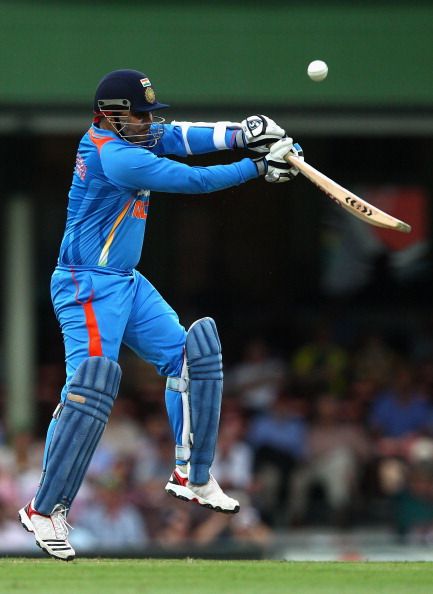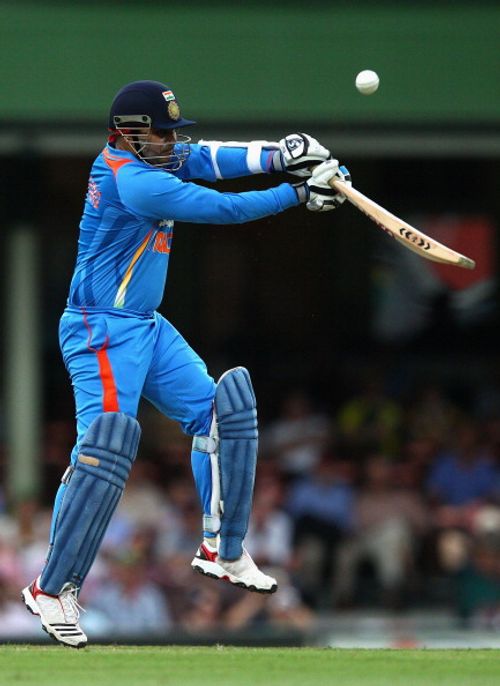
Dealing with the Sehwag Conundrum

SYDNEY, AUSTRALIA – FEBRUARY 26: Virender Sehwag of India bats during the One Day International match between Australia and India at Sydney Cricket Ground on February 26, 2012 in Sydney, Australia. (Photo by Ryan Pierse/Getty Images)
Back in 1999, it was a rarity to see an Indian fielder throw the ball a long way over the keeper’s heads from the third man region. It was rarer to see someone take the attack against the visiting Australians. Until then, only Sachin Tendulkar could do it with finesse. But this lad had no fear of the fast ball. Shoaib Akhtar would run in the hard yards to only find the ball race past the point fielder like a tracer bullet.
A 70 ball 100 is a breathtaking score in this day of T20 frenzy. Put that into perspective back to the days of 2001. That was Sehwag. He belonged to a class entirely owned by him, very early in his career.
He reminded us of Sachin Tendulkar with his every move at the crease. Be it the back-foot punch or the wristy flick or the minimalistic straight drive. Even Anjali Tendulkar couldn’t figure out who was batting when he and his hero batted together in the middle.
Virender Sehwag is a genius unparalleled. He still instills fear in his opponents, the way he did ten years ago and doesn’t seem to change his approach at all. We know batsmen who’ve toned down their aggression over years. Even Sachin Tendulkar, Sehwag’s hero himself did that in the later part of his career to achieve what the opponents fear the most – consistency!
While Sehwag looked a Tendulkar imitation for some time, he has carved his own legacy and has well and truly come out of the shadow of the great man. There is no comparison with Tendulkar anymore. Sehwag holds a place for himself in Indian cricket now. I don’t think anyone in world cricket has ever scored over 16,000 international runs with the kind of audacity he approaches his game with.
While that makes him special, the audacity has gone overboard in the last few years. There is a very thin line to maintain the audacity and yet be consistent. I can only think of Adam Gilchrist to have cast a similar effect before and now, Shane Watson is doing it consistently across all formats.
The other side of the park has Sehwag’s neighbor, Shahid Afridi. For all the batting talent Afridi came with, he has frittered away very quickly with his reckless approach. Afridi’s batting has come under heavy scrutiny among the Pakistani fans, former players, experts and media. But he doesn’t seem to worry about that.
Slowly but surely, Sehwag is crossing the Gilchrist boundary and delving into the Afridi zone. As Sehwag moves into the Afridi zone, Indian cricket is losing a genius by giving away free rein to smash bowlers all over the park. The level of aggression he displays these days should worry his fans a lot.
For the first 5 years of his test career, he cracked some virtuoso performances, both home and away, to take India to the top of the rung in test rankings. Sehwag’s batting built the foundation for many test victories abroad. He was the hero India waited to see for a long time. India seldom had good openers and he stood out with his contributions. Some rightly called him the best since Gavaskar. There was a time in his career, when he used to cross 150+ scores every time he scored a test hundred.
There was something special in him that allowed him to keep going. Even recently, he scored 293 against Sri Lanka (2010). Scoring 293 in test matches needs a lot of temperament. But in the recent past, such gems from Sehwag has become far and few in between.
When the whole of Indian batting line up were mystified by Muralitharan and the rookie, Ajantha Mendis in 2008, he smashed a double hundred all by himself at Galle to set up a test win for India. These days, he is succumbing to his own tactic. The first 5 years of his test cricket (from 2001-2006), Sehwag’s test batting strike rate has been 75.68 runs per 100 balls. In the last 4 years, his strike rate has risen alarmingly to 91.27 runs per 100 balls.
He could get away with such tactics in subcontinent tracks. But it doesn’t work well against the likes of Dale Steyn, Morne Morkel and co. on seaming and swinging tracks. His test average abroad in the last 4 years reads 33 and this definitely is not a mark of a genius.
Surely it is not the case of lack of skill. Teams still fear Sehwag. The question for Dhoni, the team management, the selectors and his fans is- will Sehwag ever rise to the occasion? Somewhere, Duncan Fletcher and Dhoni should make him realize that his wicket is extremely valuable for the team’s chances in all formats.
For the hate of Greg Chappell, Indians might not be ready to agree to his comments on Sehwag. But I certainly find that there is lot to chew upon with his assessment. Isn’t it obvious with the kind of temperament he showed in his comeback knock at Adelaide, 4 years ago? Sehwag simply desists himself from going through the rigors. No wonder Chappell believes Sehwag truly writes his own destiny.
His recent dismissals in ODIs and T20Is are worth noticing too. He thinks there is no spinner in the world who is worth playing along the carpet. Jeetan Patel snared him very easily in Bangalore test a month ago. Against South Africa a few days ago, he tried to boss over Robin Peterson only to lose his wicket. Against Shapoor Zadran, he was clueless. The ball was moving and Sehwag could only poke to that delivery moving away from him at a decent clip. Somewhere he didn’t seem to possess his strong entity – clear mind.
Roll back a few months and you would notice that both Australians and Sri Lankans managed to take Sehwag’s wicket very easily Down Under. Anything short and wide deserves punishment. But his aggressive instincts brought his downfall, as they managed to get him caught regularly at third man.
The recklessness against fast bowlers and more so against spinners isn’t doing any good for Indian cricket. This is a time in Indian cricket, when the team is looking to reclaim its glory days across all the formats. Sehwag is an important cog in this wheel and without his sterling starts, the Indian team is not the same. The time has come for Sehwag to either realize what the team needs best or give way to a youngster to take his place. If the former happens, Indian cricket could well be back to the good ol’ days, reviving the golden generation. If the latter has to happen, we might as well be sowing the seeds to unearth another batting genius.